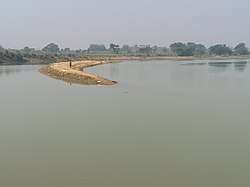Ajay river
Ajay (/ˈədʒɑɪ/) is a river which flows through the Indian states of Bihar, Jharkhand and West Bengal. The word “Ajay” means “Unconquerable”.
| Ajay River | |
|---|---|
 | |
| Etymology | Sanskrit: Unconquerable |
| Location | |
| Country | India |
| State | Bihar, Jharkhand, West Bengal |
| Cities | Deoghar, Jamtara, Katwa |
| Physical characteristics | |
| Source | |
| • location | Jamui, Bihar |
| • coordinates | 24°31′29″N 86°21′22″E |
| Length | 400 km (250 mi) |
| Discharge | |
| • location | Bhagirathi River, Katwa, West Bengal |
| Basin features | |
| Tributaries | |
| • right | Pathro and Jayanti in Jharkhand, Tumuni and Kunur in Bardhaman district of West Bengal |
Geography
The Ajay river originates from Batpar from Chakai block of Jamui[1] district in Bihar . It then enters Jharkhand near Devipur (a proposed industrial area of Deoghar) and flows through Jharkhand and enters West Bengal at Simjuri, near Chittaranjan. It first forms the border between Paschim Bardhaman district and Jharkhand and then between Paschim Bardhaman district and Birbhum district, and finally it enters Katwa subdivision of Purba Bardhaman district at Nareng village in Ketugram police station. It then joins the Bhagirathi River at Katwa Town.[2] Total length of the Ajay is 400 kilometres (250 mi), out of which 236 kilometres (147 mi) are in West Bengal.[3]
The catchment area of Ajay River is 6,000 square kilometres (2,300 sq mi).[4]
The important tributaries of the Ajay are Pathro and Jayanti in Jharkhand, and Tumuni and Kunur in Bardhaman district of West Bengal.[3]
The upper reaches of the Ajay pass through hilly regions with laterite soil. It is only from Ausgram in Bardhaman district that the Ajay flows through alluvial plains. The Ajay valley was densely forested with sal, piyasal and palas trees till recent times when mining and other activities led to the clearing of forests.[3] Recently, Government of India (Ministry of Shipping) declared Ajay River as National Waterway 7, under The National Waterways Act, 2016.{6}
History
According to the history of ancient India edited by Mc Krindle, there was a river called Amystis that flows past a town called Katadupa, in the days of Megasthenes. Another historian Wilfred opines that Amystis is modern-day Ajay.[5] In recent times there has been exploration of the remains of an ancient civilisation similar to that of the Indus Valley Civilisation at Pandu Rajar Dhibi in the lower Ajay valley.[3]
There have been at least 14 recorded floods in the 20th century caused by the Ajay river. The lower reaches of the river have embankments to prevent flooding.[3]
Jaydev Kenduli, claimed to be the birthplace of the 13th-century Sanskrit poet Jayadeva of Gita Govinda fame,[6] and Churulia, birthplace of Kazi Nazrul Islam are located on the banks of the Ajay.
See also
References
- {{Map Url=http://www.brandbharat.com/english/bihar/districts/jamui/blocks_jamui.html}}
- Chattopadhyay, Akkori, Bardhaman Jelar Itihas O Lok Sanskriti (History and Folk lore of Bardhaman District.), (in Bengali) , Vol I, p 27, Radical Impression. ISBN 81-85459-36-3
- Chattopadhyay, Akkori, p 28
- Roy, Jitendra. "The Deluge 2000" (PDF). Archived (PDF) from the original on 10 April 2009. Retrieved 2009-04-11.
- Chattopadhyay, Akkori, p 27
- There is a counter claim that he was born in Orissa.